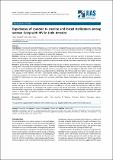| dc.contributor.author | Kendall, Tamil | |
| dc.contributor.author | Albert, Claire | |
| dc.date.accessioned | 2015-07-10T19:16:48Z | |
| dc.date.issued | 2015 | |
| dc.identifier.citation | Kendall, Tamil, and Claire Albert. 2015. “Experiences of Coercion to Sterilize and Forced Sterilization Among Women Living with HIV in Latin America.” Journal of the International AIDS Society 18 (1) (March 24). doi:10.7448/ias.18.1.19462. | en_US |
| dc.identifier.issn | 1758-2652 | en_US |
| dc.identifier.uri | http://nrs.harvard.edu/urn-3:HUL.InstRepos:17224844 | |
| dc.description.abstract | Introduction: Forced and coerced sterilization is an internationally recognized human rights violation reported by women living with HIV (WLHIV) around the globe. Forced sterilization occurs when a person is sterilized without her knowledge or informed consent. Coerced sterilization occurs when misinformation, intimidation tactics, financial incentives or access to health services or employment are used to compel individuals to accept the procedure.
Methods: Drawing on community-based research with 285 WLHIV from four Latin American countries (El Salvador, Honduras, Mexico and Nicaragua), we conduct thematic qualitative analysis of reports of how and when healthcare providers pressured women to sterilize and multivariate logistic regression to assess whether social and economic characteristics and fertility history were associated with pressure to sterilize.
Results: A quarter (23%) of the participant WLHIV experienced pressure to sterilize post-diagnosis. WLHIV who had a pregnancy during which they (and their healthcare providers) knew their HIV diagnosis were almost six times more likely to experience coercive or forced sterilization than WLHIV who did not have a pregnancy with a known diagnosis (OR 5.66 CI 95% 2.35–13.58 p≤0.001). WLHIV reported that healthcare providers told them that living with HIV annulled their right to choose the number and spacing of their children and their contraceptive method, employed misinformation about the consequences of a subsequent pregnancy for women’s and children’s health, and denied medical services needed to prevent vertical (mother-to-child) HIV transmission to coerce women into accepting sterilization. Forced sterilization was practiced during caesarean delivery.
Conclusions: The experiences of WLHIV indicate that HIV-related stigma and discrimination by healthcare providers is a primary driver of coercive and forced sterilization. WLHIV are particularly vulnerable when seeking maternal health services. Health worker training on HIV and reproductive rights, improving counselling on HIV and sexual and reproductive health for WLHIV, providing State mechanisms to investigate and sanction coercive and forced sterilization, and strengthening civil society to increase WLHIV’s capacity to resist coercion to sterilize can contribute to preventing coercive and forced sterilization. Improved access to judicial and non-judicial mechanisms to procure justice for women who have experienced reproductive rights violations is also needed. | en_US |
| dc.language.iso | en_US | en_US |
| dc.publisher | International AIDS Society | en_US |
| dc.relation.isversionof | doi:10.7448/IAS.18.1.19462 | en_US |
| dash.license | LAA | |
| dc.title | Experiences of coercion to sterilize and forced sterilization among women living with HIV in Latin America | en_US |
| dc.type | Journal Article | en_US |
| dc.description.version | Version of Record | en_US |
| dc.relation.journal | Journal of the International AIDS Society | en_US |
| dash.depositing.author | Kendall, Tamil | |
| dc.date.available | 2015-07-10T19:16:48Z | |
| dash.hope.year | 2015 | en_US |
| dc.identifier.doi | 10.7448/IAS.18.1.19462 | * |
| dash.contributor.affiliated | Kendall, Tamil | |


